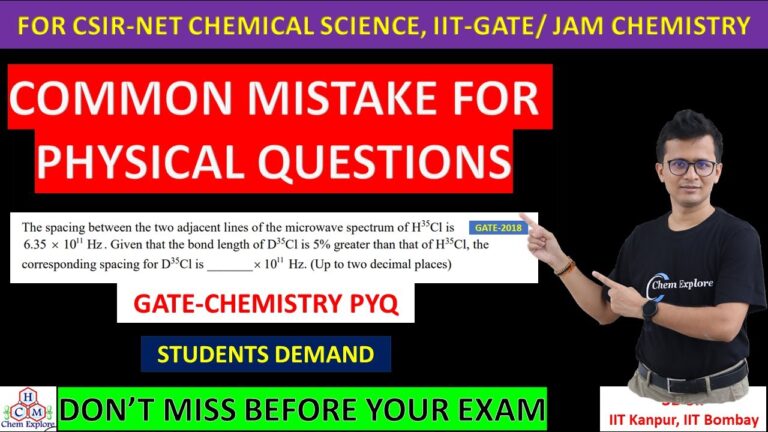Top 11 common chemistry mistakes students make and how to avoid them: simple guide to success
Introduction
Chemistry is one of the most exciting yet challenging subjects for students. It requires precision, a deep understanding of concepts, and the ability to apply theoretical knowledge practically. However, many students make common mistakes that hinder their progress. This article will outline the top 10 mistakes students make in chemistry and provide easy-to-understand solutions on how to avoid them.
1. Not Understanding the Periodic Table Properly
Mistake: Many students fail to grasp the full significance of the periodic table. They focus on just the names and symbols, missing the trends and patterns that are essential for understanding atomic behavior.
How to Avoid It:
Focus on Groups and Periods: Understand how elements in the same group (column) share similar chemical properties, and how the properties change across a period (row).
2. Forgetting Units in Chemical Calculations
Mistake: One of the most common mistakes students make is forgetting to include units in their chemical calculations. Units are essential in determining the correctness of your answers.
How to Avoid It:
Always Include Units: Whether you’re calculating molar mass, volume, or concentration, always include the appropriate units.
Dimensional Analysis: Practice converting between units and ensure they cancel out properly.
3. Confusing Acid and Base Definitions
Mistake: Many students mix up the definitions of acids and bases. Acid-base chemistry is fundamental, but it can be tricky, especially when dealing with strong and weak acids.
How to Avoid It:
Remember the Definitions: An acid donates H⁺ ions, while a base accepts H⁺ ions or donates OH⁻ ions.
Strong vs. Weak: Understand the difference between strong and weak acids/bases. Strong acids dissociate completely in water, while weak acids only partially dissociate.
4. Misunderstanding the Concept of Moles
Mistake: The mole concept can be confusing. Students often fail to understand that a mole is just a counting unit, similar to how a dozen refers to 12 items.
Read MoreThe Importance of Catalysis in Green Chemistry
How to Avoid It:
Concept of Avogadro’s Number: Always remember that 1 mole = 6.022 x 10²³ particles (atoms, molecules, etc.).
Use Molar Mass: When converting between grams and moles, always use the molar mass of a substance.
5. Neglecting to Balance Chemical Equations
Mistake: Students sometimes forget to balance chemical equations. This is crucial for understanding conservation of mass and energy.
How to Avoid It:
Start with the Most Complex Molecule: Balance elements that appear in the fewest compounds first, then move to the simpler ones.
Check at the End: After balancing, always check to ensure that the number of atoms on both sides of the equation is the same.
6. Ignoring Safety Precautions
Mistake: Many students underestimate the importance of safety in the chemistry lab. Mishandling chemicals or not following proper procedures can lead to accidents.
How to Avoid It:
Know Your Chemicals: Familiarize yourself with the properties of the chemicals you’re working with and the proper safety procedures.
Wear Protective Gear: Always wear safety goggles, gloves, and a lab coat when conducting experiments.
7. Overlooking the Importance of Concentration in Reactions
Mistake: Students often forget how the concentration of reactants affects the rate of a reaction.
How to Avoid It:
Le Chatelier’s Principle: Understand how changing the concentration of reactants or products shifts the equilibrium of a reaction.
Rate of Reaction: Study how the concentration affects the speed of a reaction.
Read More INTRODUCTION TO GREEN CHEMISRTY
8. Not Mastering Stoichiometry.
Mistake: Stoichiometry can be difficult, but many students skip over it or do not fully understand the process, leading to incorrect answers in chemical reactions.
How to Avoid It:
Master the Ratios: Always use the mole-to-mole ratio from the balanced equation to find the amount of each substance involved.
Step-by-Step Approach: Break down stoichiometry problems into smaller, manageable steps, ensuring that units cancel out appropriately.
9. Confusing Chemical and Physical Changes
Mistake: Students often confuse physical and chemical changes, which can affect their understanding of reactions.
How to Avoid It:
Physical Change: A change in the state or appearance of a substance that does not alter its chemical composition (e.g., melting, freezing).
Chemical Change: A process where the substance undergoes a transformation and forms a new substance (e.g., burning, rusting).
10. Relying Too Much on Memorization Instead of Understanding
Mistake: Students often memorize formulas and concepts without fully understanding them. This makes it difficult to apply knowledge to problem-solving situations.
How to Avoid It:
Focus on Concepts: Rather than memorizing, understand the underlying principles behind the formulas and equations.
Practice Problem-Solving: Apply the concepts to various problems to gain a deeper understanding.
Conclusion
Chemistry can be a challenging subject, but with the right approach, common mistakes can be avoided. By focusing on understanding the core principles and avoiding these ten common mistakes, students can build a stronger foundation and excel in chemistry. Remember, practice and comprehension are key to mastering the subject!
Feel free to put down your questions and view. Your opinion and contributions even the criticism are highly appreciated.



